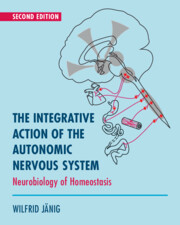Book contents
- The Integrative Action of the Autonomic Nervous System
- Reviews
- The Integrative Action of the Autonomic Nervous System
- Copyright page
- Dedication
- Contents
- Foreword to the Second Edition
- Foreword to the First Edition
- Preface
- Abbreviations
- Introduction The Autonomic Nervous System and the Regulation of Body Functions
- Part I The Autonomic Nervous System: Functional Anatomy and Interoceptive Afferents
- Part II Functional Organization of the Peripheral Autonomic Nervous System
- Part III Transmission of Signals in the Peripheral Autonomic Nervous System
- Chapter 6 Impulse Transmission Through Autonomic Ganglia
- Chapter 7 Mechanisms of Neuroeffector Transmission
- Part IV Representation of the Autonomic Nervous System in the Spinal Cord and Lower Brain Stem
- Part V The Centers of Homeostasis in the Mesencephalon and Hypothalamus and Their Telencephalic Control
- Index
- References
Chapter 7 - Mechanisms of Neuroeffector Transmission
from Part III - Transmission of Signals in the Peripheral Autonomic Nervous System
Published online by Cambridge University Press: 16 July 2022
- The Integrative Action of the Autonomic Nervous System
- Reviews
- The Integrative Action of the Autonomic Nervous System
- Copyright page
- Dedication
- Contents
- Foreword to the Second Edition
- Foreword to the First Edition
- Preface
- Abbreviations
- Introduction The Autonomic Nervous System and the Regulation of Body Functions
- Part I The Autonomic Nervous System: Functional Anatomy and Interoceptive Afferents
- Part II Functional Organization of the Peripheral Autonomic Nervous System
- Part III Transmission of Signals in the Peripheral Autonomic Nervous System
- Chapter 6 Impulse Transmission Through Autonomic Ganglia
- Chapter 7 Mechanisms of Neuroeffector Transmission
- Part IV Representation of the Autonomic Nervous System in the Spinal Cord and Lower Brain Stem
- Part V The Centers of Homeostasis in the Mesencephalon and Hypothalamus and Their Telencephalic Control
- Index
- References
Summary
Axons of postganglionic neurons branch many times close to their effector cells and have hundreds to thousands of varicosities, which contain transmitter(s) packed in vesicles. Excitation of the postganglionic neurons spreads over all its branches and invades all varicosities. Signal transmission from postganglionic neurons to most effector cells occurs through specific neuroeffector synapses. In the heart, acetylcholine released by parasympathetic cardiomotor axons reacts with junctional muscarinic receptors that are coupled via a intracellular second-messenger pathway to the cellular effectors. Arterioles and small arteries are influenced by neural release of noradrenaline and ATP from the varicosities of the vasoconstrictor axons. The ATP reacts with junctional purinoceptors and opens ligand-gated cation channels, which cause activation of voltage-sensitive calcium channels and resultant action potentials. Noradrenaline released from the postganglionic vasoconstrictor terminals reacts with junctionally and extrajunctionally located a-adrenoceptors leading to slow depolarization in some blood vessels. The influence exerted by autonomic neurons on their effector tissues may be modulated by local and remote non-neural signals. The mechanisms of neuroeffector transmission in different autonomic targets are diverse. As no exceptions have yet been found, it is not far-fetched to assume that neuroeffector transmission is specific for all target cells innervated by postganglionic neurons.
Keywords
- Type
- Chapter
- Information
- The Integrative Action of the Autonomic Nervous SystemNeurobiology of Homeostasis, pp. 200 - 226Publisher: Cambridge University PressPrint publication year: 2022



